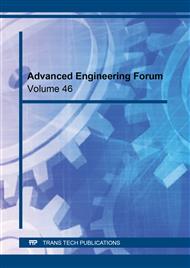[1]
S.O. Odeyemi, M.A. Akinpelu, O.D. Atoyebi, K.J. Orire, Quality assessment of sandcrete block produced in Adeta, Kwara State Nigeria, Nigerian J. of Tech. 37(1), (2018) 53-59.
DOI: 10.4314/njt.v37i1.7
Google Scholar
[2]
S.O. Odeyemi, Effect of types of sandcrete blocks on the internal microclimate of a building, J. of Res. Info. Civ. Eng. 9(1), (2012) 96-107.
Google Scholar
[3]
G. Oyekan, O.M. Kamiyo, A study on the engineering properties of sandcrete blocks produced with rice husk ash blended cement, J. of Eng. Tech. Res. 3(3), (2011) 88-98.
Google Scholar
[4]
S.O. Odeyemi, O.O. Otunola, A.O. Adeyemi, W.O. Oyeniyan, M.Y. Olawuyi, Compressive strength of manual and machine compacted sandcrete hollow blocks produced from brands of nigerian cement, American J. of Civ. Eng. 3(2-3), (2015) 6-9.
Google Scholar
[5]
G. Morenikeji, E.T. Umaru, S. Liman, M.A. Ajagbe, Application of Remote Sensing and Geographic Information System in Monitoring the Dynamics of Landuse in Minna, Niger State, Nigeria. Int. J. of Academic Res. Bus. Soc. Sci. 5(6), (2015) 320-337.
DOI: 10.6007/ijarbss/v5-i6/1682
Google Scholar
[6]
S.O. Odeyemi, R. Abdulwahab, M.A. Anifowose, R.J. Ibrahim, Impact of different fine aggregates on the compressive strength of sandcrete blocks, Arid Zone J. of Eng. Tech. Env. 15(3), (2019) 611-618.
Google Scholar
[7]
M. Abdullahi, Properties of some fine aggregates in minna, nigeria and environs, Leonardo J. of Sci. 8, (2006) 1-6.
Google Scholar
[8]
M. Anwar, T. Miyagawa, M. Gaweesh, Using rice husk ash as a cement replacement material in concrete, Waste Manag. Ser. 1, (2000) 671-684.
DOI: 10.1016/s0713-2743(00)80077-x
Google Scholar
[9]
I.K. Cisse, M. Laguerbe, Mechanical characterization of filler sandcretes with rice husk ash additions: study applied to Senegal, Cem. Concr. Res. 30(1), (2000) 13-18.
DOI: 10.1016/s0008-8846(99)00182-9
Google Scholar
[10]
U. Akeem, G. Umar, Quality assurance of hollow sandcrete blocks produced by block moulding factories in gombe metropolis. J. of Sci. Tech. Edu. 2(1), (2013) 61-65.
Google Scholar
[11]
U.N. Wilson, S.A. Raji, J.A. Alomaja, Comparative review on the use of sandcrete blocks and laterite-cement bricks in Nigeria, Ethiopian Int. J. of Multi. Res. 3(3), (2016) 32-44.
Google Scholar
[12]
NIS 444:1, Composition, Specifications, and conformity criteria for common cement. Nigerian Industrial Standard, Standard Organisation of Nigeria, Lagos, Nigeria, (2014).
Google Scholar
[13]
BS 3148, Tests for water for making concrete, British Standards Institution, British Standard, London, (1980).
Google Scholar
[14]
BS 812-103.1, Methods for determination of particle size distribution section 103.1 sieve tests, British Standard, London, (1985).
Google Scholar
[15]
M. S. Shetty, Concrete technology theory and practice, S. Chand and Company Ltd., New-Delhi, (2008).
Google Scholar
[16]
A.M. Neville, Properties of concrete, 5th ed., Pearson Education Ltd, London, (2011).
Google Scholar
[17]
J.E. Bowles, Foundation analysis and design, The McGraw-Hill Companies, Inc., N.Y, (1996).
Google Scholar
[18]
BS 1377:2, Methods of test for soil for civil engineering purposes, British Standards, London, (1990).
Google Scholar
[19]
BS EN 933-1, Tests for geometrical properties of aggregates - part 1: determination of particle size distribution - sieving method, British Standards, London, (2012).
DOI: 10.3403/01236185
Google Scholar
[20]
ACI Education Bulletin E1-07, Aggregate for concrete, Developed by committee E-701, Material for Concrete Construction, American Concrete Institute, (2007).
Google Scholar
[21]
NIS 87, Specification for standard sandcrete blocks, Nigerian Industrial Standard, Standard Organization of Nigeria, Lagos, Nigeria, (2004).
Google Scholar
[22]
I. Bahari, S. Sumarni, E.S. Murtiono, Mechanical property of straw concrete brick with additives viscocrete, AIP Conference Proceedings 2114, (2019) 1-7.
DOI: 10.1063/1.5112421
Google Scholar


